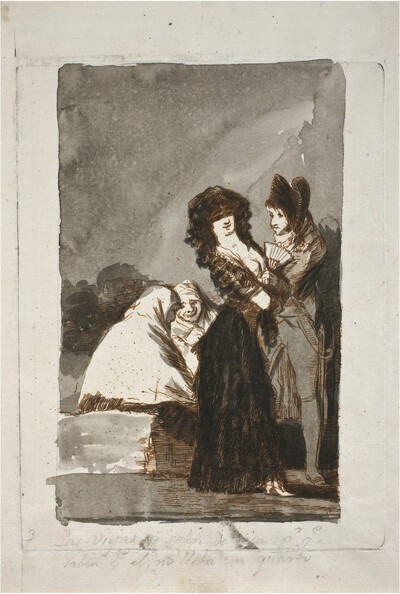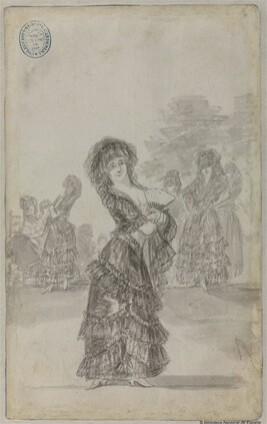- Cronología
- Ca. 1797 - 1799
- Dimensiones
- 200 x 151mm
- Técnica y soporte
- Aguafuerte, aguatinta y punta seca
- Reconocimiento de la autoría de Goya
- Undisputed work
- Ficha: realización/revisión
- 11 Nov 2010 / 29 May 2024
- Inventario
- 225
Tal para cual. (in the lower part)
P.5. (in the upper right-hand corner)
See Francisco de Goya y Lucientes, Painter.
Only one state proof is known for this print in which the use of etching and the work prior to the use of aquatint can be seen. There are also retouches in black pencil with which Goya has enlarged the female figure's mantilla, shaded the face and neck with a kind of muslin, insisted on the central part of her arm between the sleeve and the elbow and shaded the lower part of the shoulder.
In the last state test, Goya went over these retouches with drypoint and made the mound on which the old women sit and the shaded part of the sky. Finally, he applied the coarse-grained aquatint in two dark tones following the wash of Dream no. 19.
In the centre of the scene a woman, holding a fan, is receiving the attentions of a man standing a little further back, who is courting her. Behind her, in the background, two women covered from head to foot in tunics appear to be engaged in conversation.
Goya has used strong, heavy inks in black, creating a dark atmosphere that suggests the possibility that this scene is taking place at night. The lightest areas of the print are the robes of the women in the background, as well as the face and generous cleavage of the young woman in the foreground.
The Ayala manuscript indicates that it is about María Luisa of Parma and Godoy, while the Prado Museum manuscript states the following: "It has often been argued whether men are worse than women, or the opposite. The vices of both come from bad education. Wherever men are perverse, women are also perverse. The young lady depicted in the print has as good a head as the greenhorn who is talking to her; and as for the old women, the one is as vile as the other". The manuscript in the National Library states: "The Queen and Godoy when he was a Guard, and they were mocked by the washerwomen. It represents a quotation that two procuresses have provided, and that they are laughing at, pretending to pray the rosary".
It is likely that this is not just a reference to Maria Luisa ofParma and Manuel Godoy, but rather a veiled allusion to prostitution. Perhaps the maja has shown up for a rendezvous arranged for her by the two old procuresses behind her, who murmur amusedly because, possibly, they know that the man has no money. In this sense, engraving no. 5, As good as it gets , is better understood thanks to the title of his preparatory drawing The Old Women Laugh Their Heads Off Because They Know He Doesn't Have a Quarter.
This courtship scene, in which a maja and a man talk standing up while being watched by two matchmakers, has certain analogies with Caprice No. 7, Nor so distinguishes her, and Caprice No. 27, Who else is surrendered?
The plate is preserved in the National Chalcography (no. 176).
-
Goya. Gemälde Zeichnungen. Graphik. TapisserienKunsthalle BaselBasle1953from January 23th to April 12th 1953cat. 197
-
Goya. Das Zeitalter der Revolucionen. Kunst um 1800 (1980 – 1981)Hamburger KunsthalleHamburg1980cat. 232
-
Goya. La década de Los CaprichosMadrid1992organized by Real Academia de Bellas Artes de San Fernando sponsored by Fundación Central Hispano, Madrid, consultant editor Nigel Glendinnig. From October 26th 1992 to January 10th 1993cat. 72
-
Francisco de GoyaMuseo d'Arte ModernaLugano1996exhibition celebrated from September 22nd to November 17th.cat. 5, p.32
-
Ydioma universal: Goya en la Biblioteca NacionalBiblioteca NacionalMadrid1996from September 19th to December 15th 1996cat. 115
-
Francisco Goya. Sein leben im spiegel der graphik. Fuendetodos 1746-1828 Bordeaux. 1746-1996Galerie KornfeldBern1996from November 21st 1996 to January 1997cat. 11
-
Goya artista de su tiempo y Goya artista únicoThe National Museum of Western ArtTokyo1999from December 1st to July 3th 1999cat. 107
-
Francisco Goya. Capricci, follie e disastri della guerraSan Donato Milanese2000Opere grafiche della Fondazione Antonio Mazzottacat. 5, p.18
-
Goya. La imagen de la mujerMuseo Nacional del PradoMadrid2001from October 30th 2001 to February 10th 2002. Exhibitied also at the National Gallery of Art, Washington, March 10th to June 2nd 2002, consultant editor Francisco Calvo Serrallercat. 89
-
Goya e la tradizione italianaFondazione Magnani RoccaMamiano di Traversetolo (Parma)2006consultant editors Fred Licht and Simona Tosini Pizzetti. From September 9th to December 3th 2006cat. 5, p.147
-
Goya. Opera graficaPinacoteca del Castello di San GiorgioLegnano2006exhibition celebrated from December 16th 2006 to April 1st 2007p.23
-
Goya et la modernitéPinacothèque de ParisParís2013from October 11st 2013 to March 16th 2014cat. 177
-
Madrid2017
-
Agen2019cat. 54
-
Expérience GoyaLille2021cat. 34
-
2022
-
Goya engravings and lithographs, vol. I y II.OxfordBruno Cassirer1964cat. 40, p.75
-
Vie et ouvre de Francisco de GoyaParísOffice du livre1970p.176, cat. 459
-
La década de los Caprichos. Retratos 1792-1804MadridReal Academia de Bellas Artes de San Fernando1992p.118, cat. 69-73
-
Catálogo de las estampas de Goya en la Biblioteca NacionalMadridMinisterio de Educación y Cultura, Biblioteca Nacional1996p.76, cat. 93
-
El libro de los caprichos: dos siglos de interpretaciones (1799-1999). Catálogo de los dibujos, pruebas de estado, láminas de cobre y estampas de la primera ediciónMadridMuseo Nacional del Prado1999pp.76-79
-
ParísPinacoteca de París2013p. 243
-
Goya. In the Norton Simon MuseumPasadenaNorton Simon Museum2016pp. 42-75
-
ZaragozaGobierno de Aragón y Fundación Bancaria Ibercaja2017p. 265
-
AgenSnoeck2019p. 86
-
Expérience Goya (cat. expo)LilleRéunion des Musées Nationaux2021p. 86
-
Museo de Bellas Artes de Badajoz y Diputación de Badajoz2022p. 30


